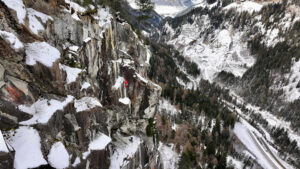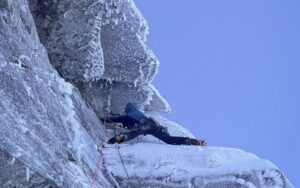Besides hosting the highest mountains in the world, Nepal features a near-endless variety of frozen waterfalls and couloirs. Many have yet to be climbed for the first time. Here’s an introduction, with the help of IFMGA-certified local mountain guide Vinayak Jaya Malla.
Like so many of his colleagues, most of the year Malla guides the 8,000’ers. In winter, however, when guiding decreases, he makes the best of his spare time.
“I enjoy ice climbing for fun, to explore new routes and refine my skills,” he told ExplorersWeb.

Vinayak Jaya Malla rock climbing in Manang some weeks ago. Photo: Instagram
Ice everywhere
Nepal has many ice climbing areas, but the most popular spots are in the Annapurna region, Manang, the Khumbu, and Rolwaling.
“Each area in Nepal offers unique climbing grades, climate variations, and approaches,” Malla said. “The difficulty grades range from WI3 to WI6, encompassing both single-pitch and multi-pitch routes spanning up to 800 meters. That means they cater to climbers of diverse skill levels.”

Winter climbing scene in Portse, Khumbu, with Vinayak leading an ice route. Photo: Pemba Sherpa
There are no crowds in winter, and ice climbers usually have the entire waterfall to themselves.
“However, some specific routes, like those above Monostray and Holy Cave, are off-limits due to local regulations or cultural considerations,” said Vinayak Jaya Malla.
Himalayan scale
The Nepali guide notes that this winter has been dry so far. Local climbers are still awaiting enough snow in certain areas, while others are ready.
A bonus in Nepal is, of course, the scenery. “Most ice walls are part of big mountains that freeze in winter, offering climbers consistently stunning views,” Malla said.
On the other hand, climbers must remember they are moving on a Himalayan scale, so some challenges may prove more complex than getting up a particular ribbon of ice.

Prakash Sherpa, another local ice-climbing pioneer and IFMGA guide, took this photo while climbing in Thame, Khumbu.
“Unlike Europe where a short drive can lead to different valleys with better conditions, in Nepal, traveling from one area to another can take at least a week,” he explained. “Additionally, some places lack a phone signal, adding to both the adventure and the isolation.”
Focusing on a single area makes sense for those with limited time. “Many routes are conveniently located near lodges, within a 20-minute to two-hour walk,” Malla suggested. “During winter, it’s essential to prearrange lodging by contacting the lodge owners, as they might be closed. In more remote areas, climbers may need to bring their own tents and food.”
Guidebook in progress
Malla is one of a thriving generation of young, internationally credited guides skilled to lead ice climbs. But independent ice climbers are also welcomed on the waterfalls.

Some climbing spots are close to villages with accommodation available. Photo: Pemba Sherpa
Malla also shared an important tip, familiar to anyone who has postholed through deep, soft snow: “Avoid venturing out alone, as breaking trail solo can be extremely challenging.”
In addition to his guiding, Malla is currently working on a guidebook of rock and ice climbing routes in Nepal. He invited everyone willing to contribute to join the online community.
“The guidebook will be free to download from the internet,” he says. “It should significantly aid independent climbers navigate Nepal’s ice climbing terrain.”
When asked about some of his favorite routes, Malla cited one of the winter jewels of the Khumbu: the Losar route, approximately 800 meters long with a grade of WI5. It’s one of the icefalls pouring from the slopes of Kongde Ri, conveniently located right opposite Namche Bazaar. Everest, Lhotse, and Ama Dablam will be watching your progress behind you as you climb.
For those not so skilled or short of time, Humde, in Manang, is the place to go.
“We explored this area in 2013 and 2014, when no one had climbed there before,” Malla said. “Just purchase an Annapurna Conservation Area permit and go. It’s a day-and-a-half drive from Kathmandu, and public transport is available. There’s no need to fly or trek, as some other areas require. You’ll find plenty of WI3 routes if you want to give ice climbing a try.”

Climbing in Humde, Manang, during the first Ice Climbing Festival in 2019. Photo: My Republica
Other winter sports
Malla sees a wide range of possibilities for outdoor winter sports in Nepal, just by aiming slightly lower than the usual peak-season objectives.

Nepali climbers use slow winter days to climb for fun and explore new areas. Photo: Manish Tamang
“While Nepal is renowned for high-altitude mountaineering and trekking, the winter season tends to limit these activities due to extreme cold and heavy snowfall,” he said. “However, ice climbing festivals in places like Manang have begun attracting climbers.”
Manang’s ice climbing festival has run twice, in 2019 and 2020, before the COVID hiatus. There is no news yet about whether it will return in 2024.
“The snow melts quickly in our region, and that can pose a challenge,” Malla admitted. “Yet some areas, such as Annapurna, Humla, Puthahimchuli, and Mera Peak, offer ski mountaineering in winter.”






